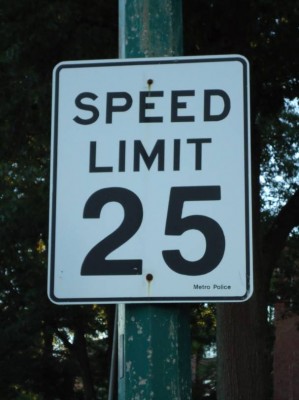
In driver’s education courses, many facts about driving are covered. These include instruction on operating a motor vehicle, safety, and rules of the road. The average student takes driver’s education either because it is compulsory or to save on the cost of auto insurance. Very few students take what they learn seriously. They just want a driver’s license and will do whatever it takes to get one.
The first step in obtaining a license is to master certain key concepts. One of the most important concepts is the speed limit. This, of course, is the speed posted on roads telling drivers how fast they can go before they will be pulled over and fined for speeding. It’s not a difficult concept, really. But, very few drivers seem able to grasp it, let alone put it into practice.
A speed limit refers not to how fast one is supposed to drive, but to the upper limit permitted by law. In other words, the part drivers don’t grasp is the word “limit.” With respect to driving, the word “limit” means the same thing as “maximum.” Maximum speed. Not speed everyone must drive.
This distinction is important for cyclists. As users of the road, cyclists often find themselves riding more slowly than the average car is driving – which, naturally, is at least five miles per hour over the speed limit.
This five mile per hour over the speed limit habit became fashionable when drivers learned that police don’t ticket drivers unless they are traveling six miles per hour over the speed limit. They give drivers an allowance of five miles per hour over the limit. Is it any wonder, with all the rushing around drivers do, that they use the extra five miles per hour to shave a minute off of their travel time?
In general, drivers tend to drive like they’re being chased by the devil. They wring every last mile per hour out of the speed limit, and cut it as close as possible, because the thirty seconds saved is time that could be used texting meaningless messages to people they see every day, but whom they can’t have a conversation with. Instead, they look down at their phones, while driving five miles per hour over the speed limit – certain that they won’t be stopped – happily tapping out communication signals to people they pretend to be connected with.
When thinking about cyclists who are traveling at a slower speed than what is posted, an important rule comes to mind: there is no minimum speed on roads other than highways. That’s right. Users of the road are not required to drive at the speed limit – they can reduce their speed, as necessary, for safe travel of the road.
Unfortunately, most drivers don’t remember this part of driver’s education. They just want to know how fast they can go, not how slowly other road users are permitted to go. And, there’s the rub. Cars are on the road to speed and don’t want anything in their way. Therefore, when a cyclist takes the lane and slows down traffic, drivers start throwing fits.
This is when they start screaming, get off the road, ride on the sidewalk, ride on a bike path, get the hell out of the way – or some variation of the above. Now, even though cyclists have the same right to use the road as any other vehicle, they have no way of educating drivers about the meaning of the term “speed limit.”
So, to begin the process of establishing guidelines for a cyclist sponsored speed limit re-education program, the International Institute of Fed Up Cyclists conducted a randomized, double-blind study of drivers to determine how they perceived the concept of a “speed limit.”
A well-respected cyclist-scientist was entrusted with quizzing a panel of carefully selected drivers to collect the data. To prevent bias on the part of the researchers, some of the study subjects had received speeding tickets, while others had never been caught speeding.
When asked the question, “what is a speed limit?” the drivers were told to submit the first thought that came to mind. Some of the more enlightening responses were as follows:
Speed limit means…
— drive 5 MPH over the posted speed
— a baseline for the game of beating police in the speeding versus ticketing contest
— a suggestion for how fast to drive
— a random number generated by the highway department to decorate the side of the road
— a Rorschach test to see if the driver can find hidden meaning in the speed limit sign’s ink blots
— practice for the vision test given at the registry of motor vehicles (you don’t have to accurately identify the characters on the sign, as long as you can see black paint on a white background)
— the Route number
— a challenge to see how fast you can drive
— a subliminal message ordering drivers to kill
Overall, the study responses were disparate. The result of the study was inconclusive, since it didn’t take into consideration reading ability. However, the data showed a clear and convincing pattern of drivers believing that the concept of “speed limit” is open to interpretation and is not meant to be taken literally.
In light of these unsettling findings, what’s clearly needed is a massive re-education campaign to teach drivers the meaning of “speed limit,” with the ultimate goal of teaching them how to share the road with bikes, how to accept slower moving vehicles, and how to stop speeding (especially when passing bicycles).
Maybe cyclists could begin the driver education process by wearing t-shirts with the slogan “When it comes to speed, limit is the maximum, not the minimum.” It’s worth a try.



3 Responses to What Is a Speed Limit?